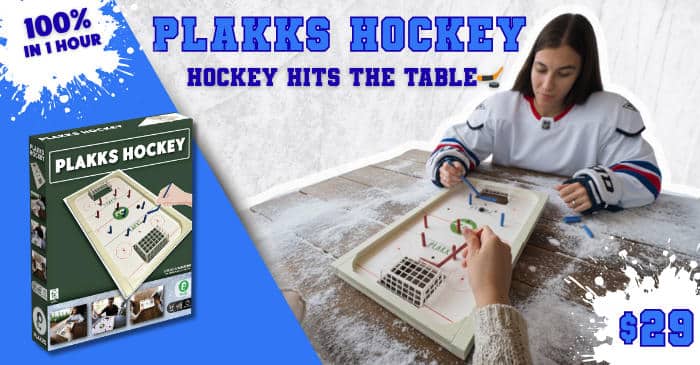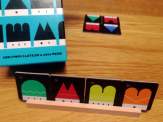| Release Date: 2006 | Players: 2-4 |
| Designer: Susan McKinley Ross | Length: 45-60 minutes |
| Artist: n/a | Age: 6+ |
| Publisher: MindWare | Complexity: 1.0 / 5 |
| Plastic (by weight): <1% | Air (by volume): 15% |
Gosh! The tiles were almost like dominoes, but square instead of rectangular. They came in a combination of six shapes and six colours. Every time you laid out tiles with the same colour, but different shapes or the same shape, but different colours, you had to connect them to what was already there, but without doubling up on colours or shapes. It quickly became confusing. It was a right Qwirkle by Susan McKinley Ross from MindWare.
Simple Rules
All right. The intro makes the game sound more confusing than it actually is. Qwirkle is really quite quick to learn. There are very few rules. On your turn, you add tiles to those already out in the middle of the table. You need to add them in a straight line, either horizontally or vertically. You either add more tiles of the same colour, as long as the shapes aren’t already there, or you add tiles of the same shape, as long as you don’t double up on the colours. Then you draw up again. That’s it. Simple, isn’t it.
Well, yes, it is. The rules are anyway. However, as more tiles are on the table, the harder it is to spot a good opportunity to add your own. Every tile you place is worth one point, but you also score the tiles that were already there. So if you add a single tile to a row of three, you score four points. Additionally, if you can complete a set of six tiles, all of the same colour or shape, called a Qwirkle, you get an extra six points as a bonus. So placing a single tile can score you 12 points, which is immense.
Knowing how the scoring works, affects how you play. You might decide to keep certain tiles, in the hope that you get more and score a complete set. Of course, the tiles you want either don’t come out or someone else gets the Qwirkle before you. It’s the risk you take. However, you can see what tiles have already been played and you know that there are three of each tile. So you can gauge how likely it is that the tiles you’re after are going to come out.
Deep Qwirkle
Even though it’s a game with very few rules and simple scoring, there is a lot of depth in Qwirkle. It’s not as deep as chess or similar, but you do need to plan ahead and have a good eye for how best to combine the tiles in front of you to give you the most points. You can even play your tiles in such a way as to block other players. Mind you, you’re unlikely to block them completely and you can never be sure what tiles other players have anyway. So Qwirkle isn’t a mean game. The player interaction is more about setting yourself up for the most points than it is about actively preventing others from scoring.

The game comes in a lovely cloth bag with big and quite chunky wooden screen-printed tiles. They seem very hard-wearing and should survive a lot of play. The bag also functions as a way to know who the next player is. The shapes and patterns you create as you play are also quite enthralling. So the game does have quite a table presence. Mind you, the six colours that have been chosen might create some issues for colour-blind people. I particularly think purple and blue are quite similar, but depending on what form of colour blindness you have, you may have problems with different colours. Unfortunately, there was no option to double-code them in this game, because shapes have their own meaning in Qwirkle.
Quick Family Fun
Teaching the game is really quick and mostly a matter of just starting to play. Playtime is also pretty quick. You should be able to finish a game in under an hour, which makes Qwirkle suitable for a fairly wide range of ages. You do need to bring your own pen and paper to keep score. Speaking of keeping score, I think that’s the only niggle I have with the game. You either ask everyone to add up their own scores or you have one player who keeps track of everyone’s points. Either way, people have to focus on what tiles they want to play while also tallying up scores.
Other than that though, I think Qwirkle is the sort of game that is perfect for family gatherings or for playing with people who aren’t much into the hobby. There is enough to keep people busy, while allowing everyone enough brain space to have a chat and enjoy themselves. So, Qwirkle away!
Keeping the blog running takes time and resources. So if you can chip in, that would be amazing.
Useful Links
- Qwirkle: https://www.
mindware. orientaltrading. com/ qwirkle-a2-32016. fltr - MindWare: https://www.
mindware. orientaltrading. com/ - BGG listing: https://boardgamegeek.
com/ boardgame/ 25669/ qwirkle
Videos
Transparency Facts
I feel that this review reflects my own, independent and honest opinion, but the facts below allow you to decide whether you think that I was influenced in any way. Please also read my Ethics Statement for more information.- I played a friend's copy of the game.
- At the time of writing, I have not received financial support from the publisher or anyone working on their behalf.
Audio Version
Intro Music: Bomber (Sting) by Riot (https://www.
The following music was used for this media project:
Music: Chill by MusicParadise
Free download: https://filmmusic.io/song/5058-chill
License (CC BY 4.0): https://filmmusic.io/standard-license
Artist website: http://www.music-paradise.de







We have been playing corkle for several years now. It’s a great game suitable for adults and children.
You need a good size clear table because you’re building your board as you go.
The bag we got is a little small and so we put the tiles in the box and hold the box over our head and pick random tiles. Not enough room to shake up the tiles in the bag at the beginning of the game.
Hello there. Thank you for your comment. I’m glad you’re enjoying the game. It’s a shame that the bag that came in your copy of the game is too small. The one I played with was very spacious.